Innovation at Work: Form-A-Calf Prime 14
Posted: May 10, 2023 | Written By: Anne Proctor, Ph.D., Form-A-Feed

Innovation is one of our core values at Form-A-Feed and the impetus for new products starts with our field nutritionists. These women and men are on farms every day helping our customers (and potential customers) solve problems. We trust that they know what you need. The ideas for new products come from discussions while walking cows, looking at calves and evaluating feedstuffs. They are then vetted by other field nutritionists to decide if the problem to be solved is one that others have as well. From there, they are discussed among members of the in-house nutrition team who answer questions like “what ingredients will help in this situation,” “will they work together in the animal,” and “how will we get them into the animal (dry feed, liquid, bolus, etc.).” Product testing starts “on the bench” where characteristics of the ingredients are evaluated and then the product goes into animal trials. These may be with university partners or on-farm field trials and our field nutritionists are involved again in identifying farms that have the capabilities necessary for the trial, working directly with farm staff to ensure the product is used as intended and they often help with data collection. As is the nature of research trials, some products hit the mark on the first try and others take many iterations to get them working well. Once the idea gains traction, other members of the team are brought in to assess how to manufacture said product and what size packaging fits the situation best taking into account the variety of customers we serve. The pricing team evaluates the costs and benefits and the marketing team develops literature to explain how the product works. The manufacturing team gets product made, packaged and into the warehouses and then the sales team takes over and introduces the result of this team effort to our customers.
Form-A-Feed is uniquely positioned to bring innovative products to market. While some might think we are “just another feed mill,” we are so much more! You know that we make feed for farm animals, but I bet you didn’t know that we manufacture feed that is shipped around the world. On a tour one day, there was an unusual odor in the air and someone inquired about it. “Oh, we’re just making feed for bees in New Zealand” was the answer and the tour continued. You never know what you’re going to hear about when visiting the plant! We have a climate-controlled room certified for blending microbials; all our feed grade probiotics and inoculants are made in house. Packaging options include the feed bags you are used to for dry feed and also hundreds of types of pails, pouches and containers. You want that in a bolus or a paste? No problem, we make those, too. Our ability to manufacture many types of products in-house gives us a huge advantage when it comes to developing new products.
2022 was a big year for product innovation with the company taking several products from concept to market in less than 12 months. Form-A-Calf Prime 14 was one of those products. It started with a discussion among team members thinking about challenges they face on farms. Many challenges were discussed and finally someone said, “What we really need is something to prevent scours in dairy calves.” There was consensus among the group that a scours product should be a priority and the wheels of innovation began to turn.
 What would we put in a scours prevention product? Scours is caused by a variety of organisms so we need components that address bacteria, viruses and protozoa. Members of our nutrition team went to the scientific literature to learn more about compounds that target specific organisms and determine the feed rate needed for efficacy. We need to support the calf’s gut and immune system. That’s where vitamins, minerals, and antioxidants come into play.
What would we put in a scours prevention product? Scours is caused by a variety of organisms so we need components that address bacteria, viruses and protozoa. Members of our nutrition team went to the scientific literature to learn more about compounds that target specific organisms and determine the feed rate needed for efficacy. We need to support the calf’s gut and immune system. That’s where vitamins, minerals, and antioxidants come into play.
The next question was how to feed it. Scours is a challenge usually affecting calves less than 21 days of age when maternal immunity from passive transfer is declining and the calf’s immunity is developing. That gap in immunity between seven and ten days often provides an opportunity for pathogens to get the upper hand. The components need to be fed daily to do their jobs so the product needs to be fed in milk or milk replacer. Feedback from the field was that it needed to be easy to mix into the liquid feed and stay in solution. The bench work was done to test mixability and make sure the product stayed in solution. This product mixes well enough to be hand-added to a bucket at feeding time and stays in solution so that the last calf being fed out of the milk taxi on a larger farm gets the same amount as the first calf.
The product then went into field testing on a large commercial dairy where we could get enough calves for treatment and control groups within a few days. This farm was struggling with calf scours which gave us confidence that our trial calves would be at risk. The calves were housed individually in calf hutches and fed milk replacer. The product was added by hand to every other calf during 1 feeding daily for the first 14 days of the calf’s life. Fecal scores, health events and body weights were recorded individually, and the data was analyzed to compare the calves fed Prime 14 with those that did not receive the product. Calves on Prime 14 gained 7 pounds more than the controls in the first 21 days of life and weekly manure scoring showed an 82% reduction in calves scoring >1 (0-3 scale where 2 is mild scours and 3 is severe scours). While data is important, the calf care team and owners of the dairy saw the benefits of the product during the trial and requested that it be added to their milk replacer as soon as the trial was completed. On this farm, the decision was made to feed the product in the milk replacer from birth to weaning. Preliminary numbers show a positive effect on weaning weights and average daily gain; more information is to come once that data is analyzed.
With such a positive response in the test calves, the team moved ahead to bring the product to market. Packaging was selected, labels were made and literature on the product was developed. The first batch of Prime 14 was made, packaged and taken to the warehouse so it was ready when introduced to the sales team. On January 16, less than a year from the original discussion, Prime 14 went on the market. There are two options for package size: a 4.4 pound pouch contains 200 doses and a single dose scoop; a 22 lb bag contains 1000 doses and is intended to be weighed and added to the milk batch. Your Form-A-Feed dealer or representative can give you exact pricing. If you feed the product for 14 days, you can expect to invest less than $3.50 per calf. Industry numbers estimate 1 case of scours to cost $50 in lost growth, treatment and labor, without taking into account the toll that caring for sick calves takes on your people.
Prime 14 is a product designed to help a calf resist the organisms that cause scours in the first weeks of life. It contains natural ingredients that have been shown to either inhibit the activity of scours organisms or support the immune system of the calf. This multi-faceted approach has proven successful in reducing the incidence and severity of scours when fed daily for the first 14 days of life. While Form-A-Feed does have essential oils and live probiotics in some of our other calf health products, the components of Prime 14 work to prevent scours through different mechanisms. If your calves struggle with scours, try Form-A-Calf Prime 14 for the first 2 weeks of life and put the power of prevention to work on your farm!